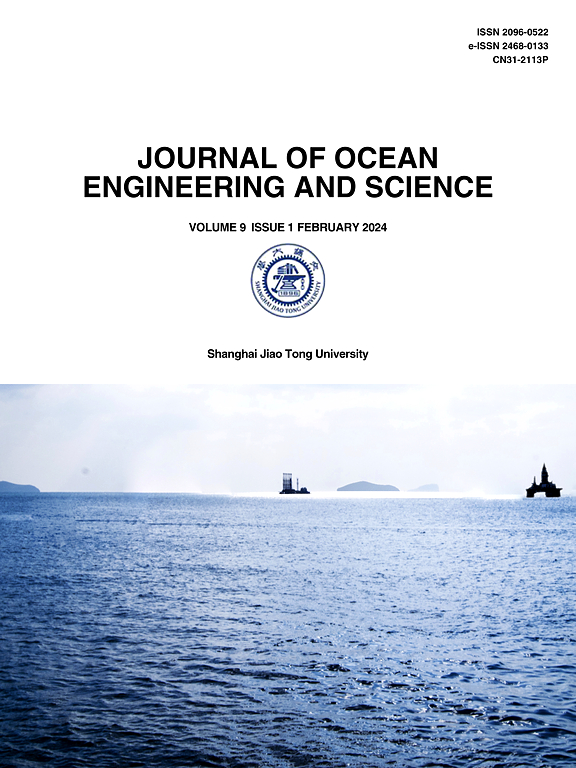Numerical simulation of violent interactions between dam break flow and a floating box using a modified MPS method
IF 11.8
1区 工程技术
Q1 ENGINEERING, MARINE
引用次数: 0
Abstract
The Moving particle semi-implicit (MPS) method is a widely used approach to simulate the violent interactions between dam break flow and downstream structures. However, most of these simulations involved fixed downstream structures and rarely considered floating objects. In this study, a modified MPS method, named MPS-SP-MG-PS method, is proposed to simulate violent interactions between dam break flow and a floating box. The proposed method includes below modifications: (1) the MPS-SP scheme with a split-pressure Poisson equation; (2) a modified space potential particle (SPP) scheme; and (3) a mixed pressure gradient and a novel particle shifting (PS) technique. Two cases are simulated, one considers heave motion only, and another considers both heave and pitch. Slamming, wave-on-deck and severe motions are involved in the cases. In order to evaluate the effect of these modifications, several numerical models with different combinations of the modifications are tested as well. Numerical results demonstrate the enhancement on stability and accuracy by these modifications: the MPS-SP scheme ensures the stability of heave motion at the initial stage; the modified SPP scheme maintains reasonable distance between free surface particles; and the combination of the mixed pressure gradient and the novel PS technique shows its accuracy in estimating box motions. Furthermore, the numerical results from the MPS-SP-MG-PS method are well consistent with experimental and existing numerical results in terms of box motions, surface elevations, fluid profiles, and slamming pressure. This indicates that the MPS-SP-MG-PS method is suitable for simulating violent interactions between dam break flow and floating structures.
用改进的MPS方法数值模拟溃坝流与浮箱的剧烈相互作用
运动粒子半隐式(MPS)方法是一种广泛应用于溃坝水流与下游结构物剧烈相互作用模拟的方法。然而,这些模拟大多涉及固定的下游结构,很少考虑漂浮物。本文提出了一种改进的MPS方法,即MPS- sp - mg - ps方法,用于模拟溃坝水流与浮箱之间的剧烈相互作用。提出的方法包括以下修改:(1)带分压泊松方程的MPS-SP格式;(2)改进的空间势粒子(SPP)格式;(3)混合压力梯度和新型粒子移动(PS)技术。模拟了两种情况,一种只考虑升沉运动,另一种同时考虑升沉和俯仰。撞击、甲板上的波浪和剧烈的运动都涉及到这些案件。为了评价这些修改的效果,还对几种不同修改组合的数值模型进行了测试。数值结果表明:MPS-SP方案保证了升沉运动初始阶段的稳定性;改进的SPP方案保持了自由表面粒子之间的合理距离;将混合压力梯度与新PS技术相结合,证明了该方法在估计箱体运动方面的准确性。此外,MPS-SP-MG-PS方法的数值结果与实验和现有的数值结果在箱体运动、地表高程、流体剖面和撞击压力等方面具有很好的一致性。这表明MPS-SP-MG-PS方法适用于模拟溃坝水流与浮体结构之间的剧烈相互作用。
本文章由计算机程序翻译,如有差异,请以英文原文为准。
求助全文
约1分钟内获得全文
求助全文
来源期刊

Journal of Ocean Engineering and Science
Multiple-
CiteScore
11.50
自引率
19.70%
发文量
224
审稿时长
29 days
期刊介绍:
The Journal of Ocean Engineering and Science (JOES) serves as a platform for disseminating original research and advancements in the realm of ocean engineering and science.
JOES encourages the submission of papers covering various aspects of ocean engineering and science.
 求助内容:
求助内容: 应助结果提醒方式:
应助结果提醒方式:


